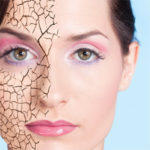By Ben Fuchs | Pharmacist Ben
The gold standard topical skin lightening ingredient is called Hydroquinone (HQ). It’ rally toxic stuff, but in small concentrations it can be an effective skin bleaching agent. If you really want to get some good effects you’re probably going to have to use 6 or 8 or even 10 percent strengths. If you want to know how effective this stuff is, just look at a picture of Michael Jackson after 2001 or so. From what I heard along the medical/dermatological grapevine, was that he was a using a super strong version of hydroquinone that was not available in the United States, and that’s where he got that white pasty look that was so striking. If you really want to lighten your skin you can probably get some good results with 4 or maybe 5 percent strength which a compounding pharmacist can prepare for you as long as you have you have a prescription Caution however, hydroquinone is toxic to the cells that make pigment, so-called melanocytes and you can actually permanently disable these very important skin components (the pigment that they make has anti aging and sun protection properties) in your attempt to lighten dark spots.
 Another less toxic skin lightening choice is retinoic acid (RA) which is a form of Vitamin A. I like using retinoic acid because not only will it lighten dark spots in a more benign fashion than HQ, but you can also use it to improve the appearance and formation of wrinkles and sun damage. It does, however, like the higher strengths of hydroquinone, require a prescription. In my pharmacy we actually make several compounded products that feature RA that are available by prescription. One particularly effective product is a combination of hydroquinone at 8 per cent with retinoic acid at 0.05 per cent. We also add hydrocortisone to reduce some of the irritation that the hydroquinone can cause.
Another less toxic skin lightening choice is retinoic acid (RA) which is a form of Vitamin A. I like using retinoic acid because not only will it lighten dark spots in a more benign fashion than HQ, but you can also use it to improve the appearance and formation of wrinkles and sun damage. It does, however, like the higher strengths of hydroquinone, require a prescription. In my pharmacy we actually make several compounded products that feature RA that are available by prescription. One particularly effective product is a combination of hydroquinone at 8 per cent with retinoic acid at 0.05 per cent. We also add hydrocortisone to reduce some of the irritation that the hydroquinone can cause.
Then there’s a third topical skin lightener that is pretty effective and I have to say that it’s one of my favorite skin lightener. It’s effective for lightening the skin and it helps protect the skin from environmental assaults from the sun and it’s important for helping stimulate the production of anti-aging fibers like collagen. I’m talking about topical Vitamin C. And, if you use the fat soluble form of Vitamin C which is called ascorbyl palmitate you can also get some nice skin moisturizing properties as well. There’s another form of fat soluble Vitamin C that is super effective for skin lightening and it’s a great moisturizer too. It’s called ascorbyl tetraisopalmitate and it’s really nice. The only problem with this form of Vitamin C is that it’s really expensive and you do need pretty high concentrations for it to work as a skin lightener, at least 10 percent and there are not a lot of companies that can afford to put that much in their product. Then there’s a new form of Vitamin C called ethyl ascorbate. This stuff is expensive too, but you only need around 1 percent or so to get some good skin lightening.
So the best topical skin lightening ingredients are basically going to be Vitamins A and C but you have to make sure they are in the correct forms if you want effective skin lightening. Retinoic acid or retinol for Vitamin A and ethyl ascorbate or ascorbyl palmitate or ascorbyl tetraisopalmitate for Vitamin C. If course, hydroquinone is effective too, but its toxicity really makes it a less viable alternative than Vitamins A and C.
Then there are the other skin lightening ingredients that only have moderate effects. I’m only mentioning these because you will see them in many over-the counter products. Probably the best of these is niacin, Vitamin B3 which is a nice skin care ingredient for a lot of things, especially acne. One of the signs of niacin deficiency is skin rashes so clearly the skin is using niacin to maintain it’s health. And recently it was discovered that you can get some of these benefits by applying niacin topically. As mentioned, topical niacin has been shown to be effective for treating acne , and you may want to dissolve a niacin tablet in water and use it as an acne mist. There are several skin care lines that are featuring niacin, and if you have blotchy skin or dark spots associated with acne this is something you might want to try.
One of the best ways to lighten the skin is to use plain old alpha hydroxy acids (AHAs). Now most people have heard of the most famous AHA glycolic acid by now, it’s been around in the over-the-counter skin care world for over 20 years and a lot longer in the medical realm. glycolic acid is the prototype example of the AHA family of chemicals (others include citric acid, malic acid, acetic acid and lactic acid) and all of these substances have some really important, interesting and helpful roles to play in skin health. In fact I would go as far as to say that alpha hydroxy acids are among the three most important ingredients you can ever use on your skin, along with Vitamin A and Vitamin C. The literature and research that is out on these substances is absolutely overwhelming. And these are research articles that have out for decades. Medical professionals have been using glycolic Acid for 50 years. I remember when I first started out in the skin care business, I had a doctor I was working with, who loved this stuff. He had me making all kinds of glycolic acid products on a prescription basis and he swore by the stuff. Then AHA products came out as over the counter in the early 90’s and the cat was out of the bag; they basically revolutionized the skin care business. AHAs are to this day, the gold standard of active anti aging ingredients, the skin care substances that all ingredients are compared to. They basically up-regulate every single marker of skin health that you could name including improving collagen synthesis, hyaluronic acid synthesis, they improve moisture factor production helping skin stay soft and hydrated . They improve fine lines and wrinkles and they are excellent for helping remove pigmented skin.
There’s a couple of different ways you can use alpha hydroxy acids to lighten the skin. The best way is to go to an esthetician and have a skin peel done. In fact if you’re really interested in anti-aging for the skin you should find yourself a good esthetician and have regular skin peel treatments done say every 2 to 4 weeks. You can also go the slower route and get yourself a good alpha hydroxy acid product a cleanser or toner are the best and use them at home. The trick to using good alpha hydroxy acid products is you want to look for a low pH. There are a lot of these things out there, but in my experience, the acidity of most is not very satisfactory. The pH is a measurement of how acid something is and the pH scale runs from 0 to 14 where the lower numbers are acid and the higher numbers are not acid. 7 is considered neutral and skin’s normal pH is slightly acidic around 5 or 6. For an alpha hydroxy acid product to be useful for anti aging or removing pigment, it has to be lower that the skin’s normal pH. Maybe around 3 or 4. Most alpha hydroxy acid products that you buy in the department store are not going to be that low, so you probably want to go to an esthetician that you can trust to but alpha hydroxy acid products that are going to work. In any case, I like using AHA products to lighten the skin topically, because of all the extra benefits that you get. In addition to improving the tone and color of the skin alpha hydroxy acid products can soften and smooth and generally make the skin look a lot better. I personally use an AHA cleanser every day and then I do an AHA peel on my skin once every 7 to 10 days. Another benefit to using alpha hydroxy acid cleansers and toners is that they help improve the penetration of topical vitamins. The two most important topical vitamins for the skin are vitamin C and vitamin A and as we’ve said both of these are also good skin lighteners. They’re also the most effective skin vitamins for general skin health and anti-aging, and between these three ingredients, alpha hydroxy acids, vitamin A and vitamin c you have the three most important skin care ingredients you can ever use. I always tell my patients that if you are stranded on a desert island and you can only bring three ingredients with you, if you bring AHAs Vitamin A and Vitamin C, you’ll be all set!














